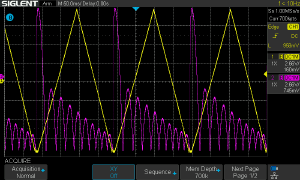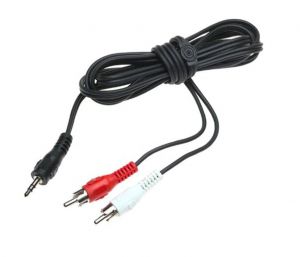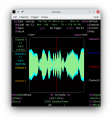Software Oscilloscopes
To watch and measure the values and curves produced during an analog computation or simulation you need additional instruments. The Analog Thing contains a voltmeter as instrument to setup the coordinates or OP_TIME values. Depending on the mode of operation in REP with predefined operation time or OP with infinite operation this display may be useful for static or slow moving values only.
To measure faster events or display signal curves the best tool is an oscilloscope. For longer operation times (REP, 0.1-10s) a digital storage oscilloscope (DSO) is preferred rather than an analog oscilloscope with a cathode ray tube (CRT). These DSO did get cheaper in the last years but useful DSO's with minimum 2 channels and XY mode are in the price range of about 150-300 € up. XY mode is useful for many applications and allow a better view of complex signals than displaying them just over the time in Yt mode. The typical Lissajous figures for example require the XY mode.
There are low cost oscilloscope on the market as well in the range of 40-100 € as well but these come with missing features and have mostly only one channel to display like DSO 138 or missing XY mode like DS 212/213. This is only partly useful with analog computations or simulations and all theses cheap handhelds have only a very small display. Some low cost oscilloscopes come without a display and are connected to a computer as display by software. So what are the requirements to met with an oscilloscope for The Analog Thing ?
Minimum requirements
- analog oscilloscope with CRT display or software display while connected to computer
- 2 channels minimum
- XY display mode
- 100 kHz bandwith
Better requirements
- 4 channels or separate trigger input
- DSO type (digital storage)
What follows is a curated list of Software oscilloscopes (also abbreveated as Softscopes). While basically any modern digital storage oscillscope is formally a softscope, we want to discuss here only software running on commodity/consumer level hardware such as on
- Desktops and Laptops: Windows/Mac/Linux
- Mobile devices: tablets and smartphones
- Embedded: System on chips and microcontrollers, such as Raspberry Pi and Arduino
For data aquisition, several techniques exist:
- Soundcard input for mono or stereo audio recording
- ADCs on boards for analog to digital conversion, typically embedded within microcontrollers
Soundcard based input
In this case, the idea is that you connect your Analog Thing to your Soundcard input with a simple Chinch-to-jack adapter, such as depicted in the right. This allows to connect to the 3.5mm phone connector (German: Klinke) which is still present in many notebooks, tablets, smartphones, also for some single board systems (unfortunately not Raspberry Pi). If your system does not have such an input, you may use a USB adapter (often referred to as USB sound card). For a list of possible hardware, see the article about Soundcards.
Note that a single chinch socket has to pins: One for ground, one for the signal. This puts it on equal footing with a BNC connector or a mono phone connector. The adapter shown on the right joins two outputs together to a stereo sound signal.
List of software based oscilloscopes
Xoscope linux desktop oscilloscope
Oscilloppoi Mac OS X desktop oscilloscope







